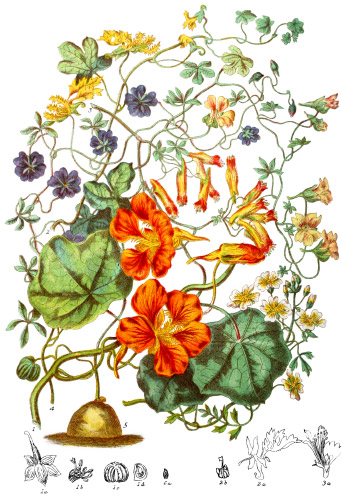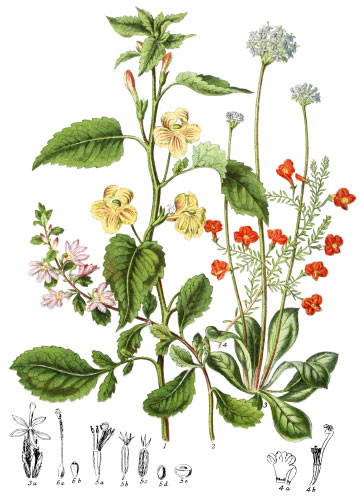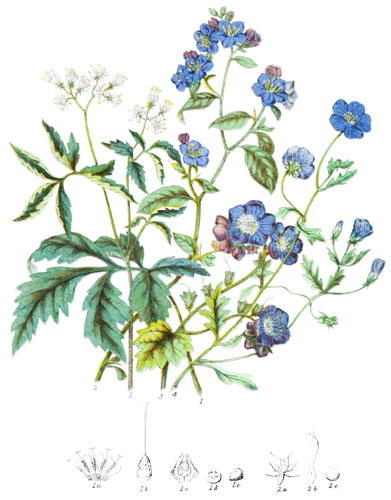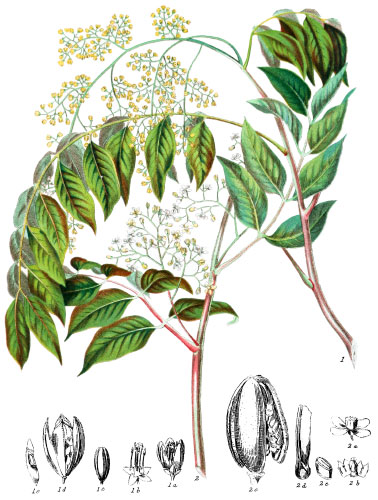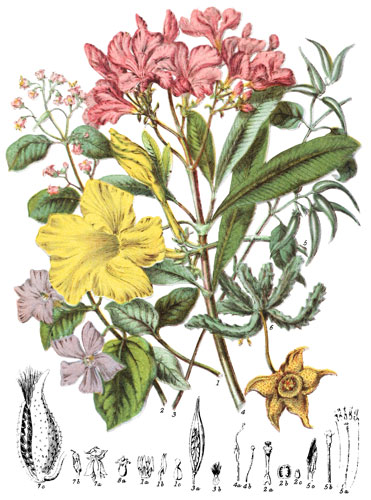Key characteristics
Trees and shrubs; the leaves are undivided, entire at the edges, or serrated, leathery, smooth, without stipules; some are undershrubs, with opposite or ternate leaves. The flowers are small, and grow in umbels, or panicles, or from the base of the leaf-stalks; seldom from the ends of the branches. The calyx is four or five-lobed, persistent. The corolla is of one petal, attached to the base of the ovary, divided at the top into four or five equal segments, often marked with sunken dots or glandular lines. Sometimes the stamens and pistils are in separate flowers; the stamens are four or five, opposite to the segments of the corolla, and inserted into its base; the filaments are distinct, rarely connected, sometimes wanting; occasionally five imperfect petal-like filaments are alternate with others; the anthers are attached to the filaments by their base, and open by two longitudinal cells. The ovary is free, or partially adherent to the calyx, with a single cell, containing many ovules. The styles is single, often very short, the stigma undivided or lobed. The fruit is fleshy, containing one or many seeds. The seeds are angular or roundish, with a hollow scar and a single covering; they contain abundant horny albumen.
This Tribe is allied to Sapotaceæ, chiefly through Jacquinia; and to the Mangrove tribe by Ægiceras.
Slightly pungent fruit and astringent bark are the only known properties of these plants.
Select plants in this order
Not all plants listed are illustrated and not all plants illustrated are listed.
- Myrsine is a genus of evergreen shrubs dispersed over a wide range of latitude in Africa, although the whole tribe is very limited in its geographical boundaries.
- M. africana grows at the Cape of Good Hope, in Abyssinia, and in the Azores, at the northern limit of these plants.
- M. retusa (1) is a shrub about two feet high, with small flowers, scarcely visible amongst the leaves, but beautifully marked with red dots, as seen in the microscope.
- The berries of M. bifaria are said to have medicinal properties; the plant is sometimes called Box by European travellers on the Himalaya, where it grows with an aspect similar to that of our English garden plant so called.
- M. semiserrata and M. acuminata ascend as high as Mussooree, above all other species of the tribe in that mountain region, excepting Mæsa argentea (6)† and M. indica.
- Suttonia divaricata (2) is remarkable as being the only shrub growing on plains on a level with the sea between 35° and 52° of S. lat. It is frequent in the woods which border the sources of rivers in the Bay of Islands in New Zealand; in Lord Auckland’s Isle, in 50°, it becomes more woody and straggling, but is of pleasing aspect when the berries are ripe. This is one of the species of his tribe scattered over a considerable space of latitude, where the temperature is favourable, especially in islands.
- Ardisia is an ornamental evergreen genus, belonging both to the East and West, in hot latitudes.
- A. solanacea embellishes the moist valleys of Coromandel with its fine red and white flowers, with large erect anthers, and profuse abundance of bright red berries, which have the property of staining paper brown.
- A. punctata and A. lentiginosa are natives of China.
- A. excelsa, the tallest species, grows in Madeira, and is a tree thirty feet high, the leaves shaped like those of the Laurel.
- A. crenulata (3) attains about ten feet in its native country, but is not usually so large in English conservatories. The red berries remaining throughout the winter, render it a very desirable species for cultivation.
- A. acuminata is a native of Guiana.
- Jacquinia was named after Nicolas von Jacquin, a celebrated Dutch botanist, who resided and studied many years at Vienna, where he published several excellent works on plants, with coloured plates, chiefly from specimines in the botanic gardens of Schoenbrunn and Vienna, founded by the wise Maria Theresa.
- J. aurantiaca (4) is remarkable for its colour.
- J. armillaris is a finer species, with white flowers, the branches of which are woven into garlands in America.
- Embelia robusta (5), embilla in Ceylon, is one of the largest trees of the tribe, affording useful timber and valuable shade. The berries are said to be unwholesome.
- Theophrasta records the name of one who, 350 B.C., studied and wrote on the natural history of plants, in Lesbos and Athens.
- T. Jussiæi combines the modern botanist and ancient sage; it is a prickly evergreen shrub growing in St. Domingo, there named le petit Coco. The seeds are pounded and made into a kind of bread, much eaten by the natives.
- Clavija of South America has a pleasant fruit, and a root useful in medicine.
- The fruit of Reptonia buxifolia, the Goorgoora of Cabool, is sold in the bazaars, but not relished by Europeans; it is about the size of a cherry, and very succulent.
- Ægiceras is a singular genus, differing in the seed-vessel being follicle, and the seeds destitute of albumen. It has the peculiar power of sending roots out of its seeds in moist air before reaching earth. Resinous glands have been discovered in the wood, flowers and fruit of several species.
Locations
This Tribe inhabits chiefly in the Indian Ocean. No species have been discovered in Asia further north than in latitude 40°, in Japan. In Africa, none are known to extend beyond the Tropic of Cancer, on the north. Myrsine floridana is the only species of North America, in latitude 30° north. None belong to Europe.
Legend
- Myrsine retusa, Small-leaved Myrsine. Azores.
- Flower.
- Stamen.
- Pistil.
- Suttonia divaricata, Straggling Suttonia. Lord Auckland’s Isle.
- Flower.
- Variety of Pistil.
- Section of Fruit.
- Ardisia crenulata, Crenulate-leaved Ardisia. West Indies.
- Flower.
- Section of Fruit.
- Seed.
- Jacquinia aurantiaca, Orange-flavoured Jaquinia. Sandwich Isles.
- Embelia robusta. Ceylon.
- empty
- Seed of Mæsa argentea.†
- *5a was not named in the original description.
- †6a was not in the original illustration.
Explore more
Posters
Decorate your walls with colorful detailed posters based on Elizabeth Twining’s beautiful two-volume set from 1868.
Puzzles
Challenge yourself or someone else to assemble a puzzle of all 160 botanical illustrations.

